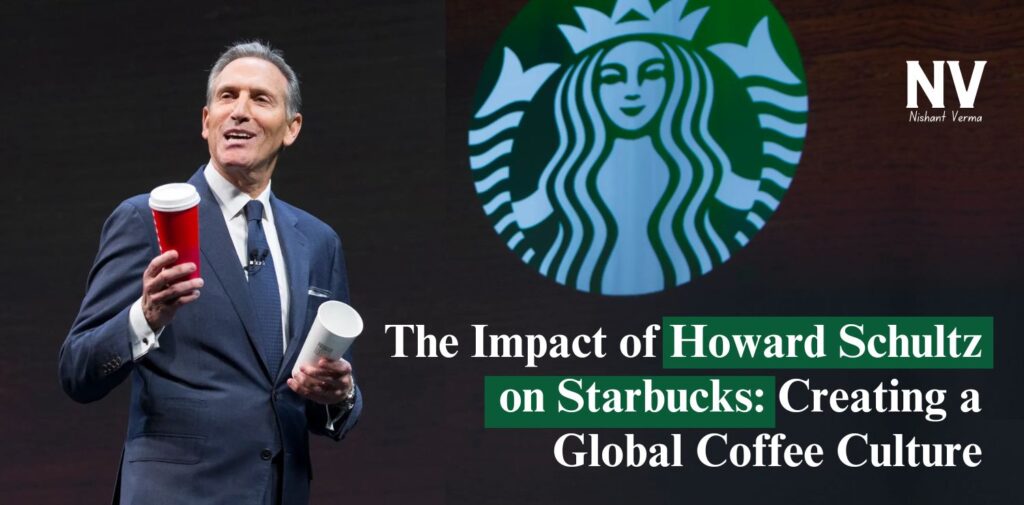In the world of business, some leaders leave an indelible mark on the companies they lead, shaping not only their growth but also entire industries. One such leader is Howard Schultz, the visionary behind Starbucks’ transformation from a small coffee bean retailer to a global coffeehouse empire. Schultz didn’t just build a company; he created a culture. He turned Starbucks into a place where people gather, connect, and experience coffee in a way that no one had before. This article explores how the leadership of Howard Schultz on Starbucks revolutionized and, in the process, helped create a global coffee culture that is now part of daily life for millions of people around the world.
The Early Days of Starbucks and Howard Schultz’s Vision
Starbucks began in 1971, founded by three entrepreneurs—Jerry Baldwin, Zev Siegl, and Gordon Bowker—who initially sold high-quality coffee beans and equipment for brewing coffee at home. The company’s first store was located in Seattle’s Pike Place Market, and for many years, Starbucks was a niche business catering to a specific group of coffee enthusiasts. But despite its success, the company was still just a coffee bean supplier and had no presence as a café-style coffeehouse.
Howard Schultz entered the picture in 1982 when he joined Starbucks as the Director of Retail Operations and Marketing. He had previously worked at the Swedish company, Starbucks was buying its espresso machines from, and after visiting Italy, Schultz had a life-changing experience. The coffee culture in Italy was vibrant and completely different from what he had seen in the United States.
In Italy, coffee wasn’t just about the drink—it was about the experience, the atmosphere, and the community that gathered around the coffee. Schultz saw potential in turning Starbucks into more than just a place to buy coffee beans. He envisioned creating a place where people could experience coffee in a new way—by sitting down, relaxing, and socializing in a welcoming, comfortable environment.

Transforming Starbucks into a Coffeehouse Culture
When Schultz shared his vision with Starbucks’ founders, they were hesitant. They believed Starbucks should remain focused on selling high-quality coffee beans. However, Schultz’s passion and determination paid off, and in 1987, he bought the company from its original owners and began turning his vision into reality. This marked the beginning of Starbucks’ journey from a small local business to a global coffeehouse giant.
Schultz made several key decisions that would redefine what Starbucks stood for:
- Expanding Beyond Coffee Beans: Schultz expanded Starbucks from just selling coffee beans to serving espresso drinks in a café setting. He wanted customers to enjoy the experience of drinking coffee in a social, relaxing environment—just as they did in Italian cafes. This was a shift from the traditional American way of drinking coffee at home or in a fast-food setting. Starbucks began offering a variety of espresso-based beverages like lattes, cappuccinos, and mochas, and with that, Starbucks became a full-service coffeehouse.
- Creating a “Third Place”: One of Schultz’s most significant innovations was the idea of creating a “third place” for people. Starbucks was designed to be more than just a place to get coffee—it was meant to be a comfortable space for people to relax, meet friends, work, or even have business meetings. The “third place” concept refers to the idea that people spend most of their time at home or work, but Starbucks could provide a space in between—a place for social interaction and community building. This idea resonated deeply with consumers and became a core part of the Starbucks brand identity.
- Fostering Customer Loyalty: Schultz understood that customer loyalty was key to Starbucks’ success. Instead of just focusing on selling coffee, he wanted to build a strong relationship with customers. Starbucks introduced a customer loyalty program, allowing frequent visitors to earn rewards. The company also trained its baristas to engage with customers, learn their names, and even remember their favourite drinks. This personalized approach made customers feel valued and created a strong bond between them and the brand.
- Quality and Consistency: From the beginning, Schultz made sure that Starbucks maintained a commitment to high-quality coffee. The company sourced its beans from around the world, and Starbucks became known for its premium Arabica coffee. Schultz also invested in training baristas to ensure that every cup of coffee met the company’s high standards. This commitment to quality and consistency made Starbucks stand out in a crowded market and helped build its reputation as a premium coffeehouse.
- Global Expansion: Schultz’s vision didn’t stop at creating a unique customer experience in the U.S. He wanted to bring Starbucks to the world. Starting in the 1990s, Starbucks began expanding internationally, opening stores in cities across Europe, Asia, and beyond. The company’s global expansion was not just about selling coffee; it was about spreading the Starbucks experience worldwide. In each new country, Starbucks adapted to local tastes and preferences while maintaining its core values and culture. By the early 2000s, Starbucks had become a truly global brand, with thousands of stores in countries all over the world.

The Rise of Coffee Culture
Howard Schultz’s impact on Starbucks was not just about the company’s growth; he also played a key role in shaping a global coffee culture. Before Starbucks, coffee in the U.S. was primarily associated with quick, low-quality coffee from chains like Dunkin’ Donuts or fast-food restaurants. There was no widespread appreciation for speciality coffee or the kind of coffeehouse culture that existed in Europe. Schultz’s vision changed that. Starbucks introduced a new way of thinking about coffee—no longer just a commodity but an experience to be savoured and enjoyed.
Schultz’s efforts to elevate coffee culture were felt worldwide. As Starbucks opened in different countries, it helped introduce people to the idea of espresso-based drinks, high-quality coffee, and the experience of sitting in a café. The idea of “coffee as an experience” caught on quickly, and before long, coffee shops and cafes began popping up all over the world, many of them inspired by Starbucks.
Moreover, Starbucks played a significant role in making coffee a global social activity. It encouraged people to slow down and enjoy their coffee, whether it was in a bustling city or a quiet suburb. The concept of the “coffee break” became a cultural norm, and Starbucks was at the heart of this change.

Challenges and Criticism
Despite Schultz’s incredible success in transforming Starbucks into a global brand, the company has faced challenges and criticism over the years. As Starbucks expanded, it faced competition from other coffee chains and local coffee shops. Critics have also argued that Starbucks contributes to the homogenization of global culture, with the company’s stores sometimes being seen as cookie-cutter versions of each other, lacking in local character.
Additionally, Starbucks has been criticized for the prices of its drinks, with some customers questioning whether they are paying too much for a cup of coffee. Despite these challenges, Schultz’s focus on quality, customer experience, and innovation has helped Starbucks remain one of the most successful and influential brands in the world.
Conclusion: Howard Schultz on Starbucks
Howard Schultz’s leadership at Starbucks has left a lasting legacy on both the company and the global coffee culture. Through his vision and determination, Schultz created not just a successful business but a cultural phenomenon. Starbucks is now a place where people connect, relax, and enjoy coffee in a way that was unimaginable before Schultz’s influence.
Schultz transformed Starbucks into a symbol of quality, community, and the idea that coffee is more than just a drink—it’s an experience. His dedication to creating a welcoming space for customers and his commitment to quality set a new standard in the coffee industry, one that many others have tried to replicate. Today, Starbucks is not just a coffeehouse; it is a global icon that has played a central role in changing the way the world thinks about coffee.
In many ways, Schultz’s story is a reminder that with passion, vision, and determination, anyone can change the world. He turned a simple idea into a global movement, and in doing so, he showed the world that coffee is not just a beverage—it’s a part of life, a culture, and a community.




